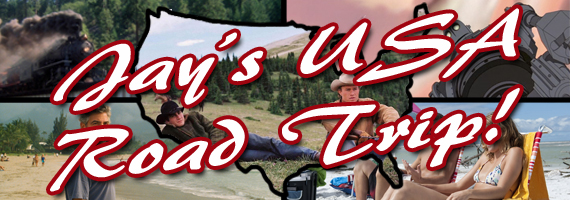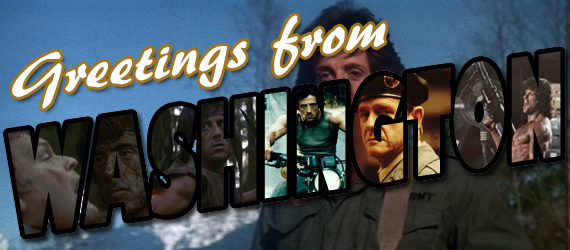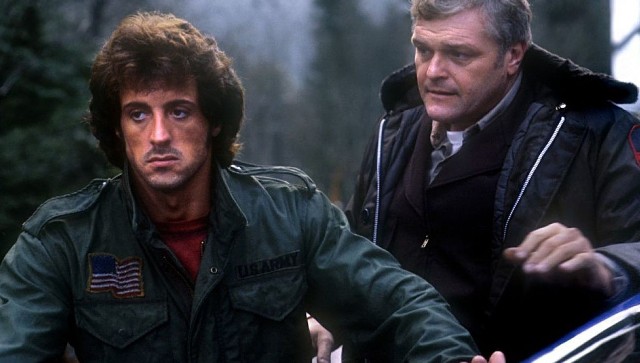
I’ve always wanted to travel across America. I’ve been a few times, to the major tourist attractions – Disneyworld in Florida, Vegas in Nevada, Cheers in Boston – but there’s so many places I’ve never seen in person, and most likely never will. Fortunately, there’s a solution, and it’s my own personal remedy to all life’s problems: movies. There’s been a movie set literally everywhere. Everywhere! So, this feature sees me cinematically visit a new state every week, through a film that was set there. You can read my journey so far here. Next up: Washington!
 After catching the train across Alaska, I’ve made a bee-line through Canada and now entered the small town of Hope, Washington for the first part of the Rambo saga, First Blood (although technically it was shot in Hope, British Columbia). John Rambo, Vietnam veteran, green beret and recipient of the congressional medal of honor, is looking for an old war buddy of his. Upon hearing the news of his death – thereby making Rambo the only surviving member of his platoon – Rambo’s day is exacerbated further when the town’s sheriff (Brian Dennehy) denies him access because of his haircut, curmudgeonly manner and generally unkempt appearance. When Rambo fails to comply he’s locked up, but once the small town cops start antagonizing him, out things start to get messy.
After catching the train across Alaska, I’ve made a bee-line through Canada and now entered the small town of Hope, Washington for the first part of the Rambo saga, First Blood (although technically it was shot in Hope, British Columbia). John Rambo, Vietnam veteran, green beret and recipient of the congressional medal of honor, is looking for an old war buddy of his. Upon hearing the news of his death – thereby making Rambo the only surviving member of his platoon – Rambo’s day is exacerbated further when the town’s sheriff (Brian Dennehy) denies him access because of his haircut, curmudgeonly manner and generally unkempt appearance. When Rambo fails to comply he’s locked up, but once the small town cops start antagonizing him, out things start to get messy.
The Rambo films have a certain degree of expectation applied to them. They’re infamous for their ever increasing body counts, questionable stances on international politics and shots of a shirtless Sylvester Stallone grunt-screaming as he unloads a machine gun into hoardes of dispensable goons. However, that all starts in First Blood: Part 2. Here we have a much more personal affair, more of a thriller than an all-out guns-blazing actioner, with a psychologocially fragile, PTSD-suffering protagonist pushed too far by a society that neither wants him nor knows what to do with him. This all added up to a rather nice suprise, especially with regards to the story (co-written by Stallone and based on David Morrell’s novel of the same name).
Stallone’s reputation as an actor has fallen into parody in the past decade or so, but here he proves he can handle emotional scenes, especially at the gut-wrenching climax. Elsewhere he ably makes his presence felt with very little dialogue in the middle section of the film. There’s some rather squirm-inducing moments of gore provided by traps Rambo sets up for his pursuers, but this is nicely offset by the occasional comedic beats, such as the have-a-go weekend warrior amateur army sent in to bring the escapee down.
This is an 80s film, so you know at some point a police car will come flying over a hill – possibly a railway track – with at least 8 inches between the tyres and the ground, elsewhere two cars will immediately burst into flames upon colliding with one another, and a speeding car will wipe out a roadblock, scattering the dozen or so cops holding it up, but you can forgive these stereotypes as they do help quicken the pace during the myriad action scenes. It goes a little too far in the movie’s last stand, as the sight of Rambo using his jungle warfare tactics in a domestic location drew a smile to my face that was probably unintended, yet welcome nonetheless.
That being said this is an otherwise fairly flawless film. Richard Crenna is wonderful as Colonel Trautman, Rambo’s commanding officer who arrives to save the town from his man, along with a warning that they’re going to need a good supply of bodybags. David Caruso crops up as a rookie cop and Brian Dennehy is gloriously detestable as the chief with a vendetta against the miscreant destroying his town. The effects are a little dated, and the finale may use an explosion or two more than completely necessary, but they don’t detract from the film too badly, and are easily forgiven when you consider such moments as Rambo turning his knife into a torch, or him tackling a dirtbike rider to steal the vehicle.



